Pambamarca 2009, The Field School, Week 2
[ Vacation Diaries ] [ Pambamarca 2009 ] [ Previous Page ] [ Next Page ]
Sunday, June 28, 2009, Hacienda Guachala, Ecuador, about 1530 ECT
(GMT -6)
Today is Sunday, our official day off. We slept in until Chad (one
of the two program directors) knocked on our door telling us that
breakfast was at 0815. We had been told last night that there would not
be a breakfast today. We dragged our backsides out of bed to get to
breakfast.
Sometime yesterday, the hot water vanished. For some reason, the hot
water was turned off or failed, I'm not clear which, but I didn't get a
shower yesterday afternoon and I needed one very badly after coming
down from working at Molinoloma.
The stables consist of 21 arches, two per room. The odd arch is in
the center and is used for storage and housekeeping supplies. The water
heaters, four of them, are in there too. Two each are plumbed in
parallel and each pair services one end of the building. The room isn't
locked so I went in there to see what was wrong. The two heaters for
our side of the building were cold. However, I wasn't about to touch
anything because the Ecuadorian electrical codes leave a lot to be
desired. The switches for the heaters were EXPOSED KNIFE switches. All
the switches seemed to be in the same position and the breakers didn't
appear to be tripped. I could not tell what was wrong but since both
heaters on one side were cold, it was pretty clear that there was an
electrical problem. I reported the problem to Chad and somehow, he
reported the problem to the hotel staff on a Sunday morning.
Manuel, the Hacienda repair man, came by after we got back from
breakfast and said that it was fixed and we'd have hot water by 1000.
By 1030, still no hot water. As we were leaving the Hacienda we saw him
in the courtyard and he asked if it was fixed. We said no and he was
clearly not happy, he said he'd work on it again.
Then we caught a bus to Cangahua, about 2 miles up the road to see
the Festival. This is a celebration of the Summer Solstice and the
Festival runs for at least 10 days. The bus fare is $0.15 per head from
the Hacienda to Cangahua.
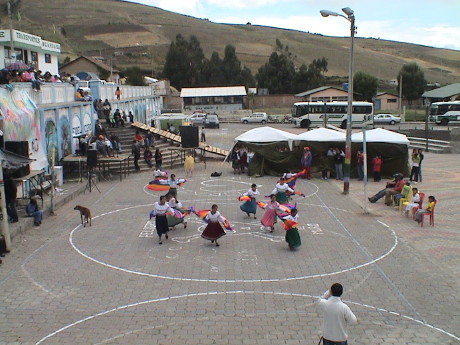 Cangahua is a pretty
small town, but they have the typical plaza with town's church on one
side. We got off the bus at the plaza and the activity was already
going on. We stopped to watch a series of dancers doing customary
Ecuadorian dance routines. Many of the dancers were children and all of
them were putting on a very good show.
Cangahua is a pretty
small town, but they have the typical plaza with town's church on one
side. We got off the bus at the plaza and the activity was already
going on. We stopped to watch a series of dancers doing customary
Ecuadorian dance routines. Many of the dancers were children and all of
them were putting on a very good show.
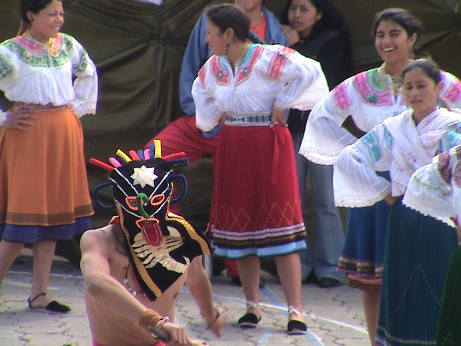 One young man was
obviously a special dancer. He had one a traditional dancing mask and
his routine was quite polished.
One young man was
obviously a special dancer. He had one a traditional dancing mask and
his routine was quite polished.
 The backside
of his mask also had a face. We believe that this is because it is
considered disrespectful to face away from the sun god which is
represented by the sun. This is a tradition in Mesoamerica and it
appears to be the same here.
The backside
of his mask also had a face. We believe that this is because it is
considered disrespectful to face away from the sun god which is
represented by the sun. This is a tradition in Mesoamerica and it
appears to be the same here.
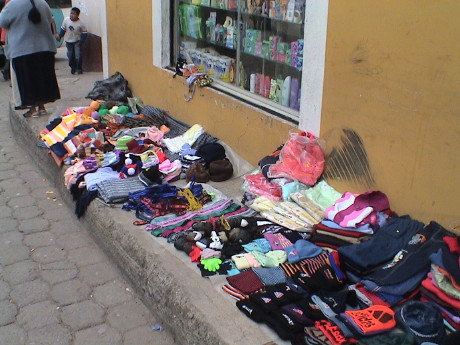 On a street at one corner
of the plaza were some small shops and street vendors selling
traditional Andean clothing, hats and accessories. We didn't buy
anything because Sandy thought that the prices were a little too
high.
On a street at one corner
of the plaza were some small shops and street vendors selling
traditional Andean clothing, hats and accessories. We didn't buy
anything because Sandy thought that the prices were a little too
high.
There were several staff members from the project there watching the
dancing. Eric bought a shishkabob like thing from a street vendor there
for $0.75. It looked pretty good so I got one and then several other
staff members bought one. It had a piece of sausage on the end, then a
plantain, then a couple of pieces of chicken and then a potato. It was
indeed really good. However, by tomorrow, we'll either have our normal
staff or be very shorthanded depending on the the quality of the
food.
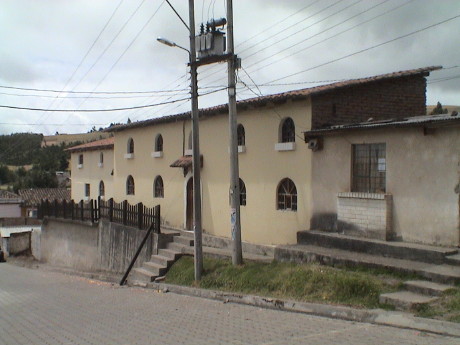 The majority of the staff
and all of the Foothill College students are staying in the Casa
Communa. This is actually an old convent located right up the street
from the plaza. The project rents the building from the church and
hires some local help to cook and clean.
The majority of the staff
and all of the Foothill College students are staying in the Casa
Communa. This is actually an old convent located right up the street
from the plaza. The project rents the building from the church and
hires some local help to cook and clean.
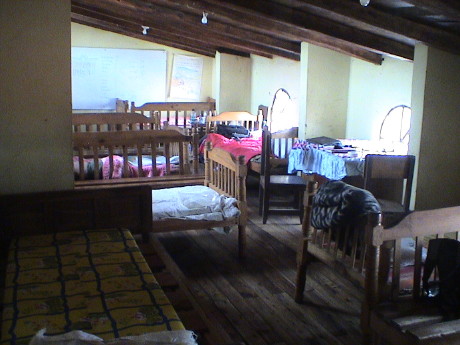 The accommodations inside
the Casa Communa are much more spartan than the Hacienda. The staff
says that the food is actually better at the Casa Communa, but it is
pretty good at the Hacienda. The bathroom features are also communal
and there is only one bathroom although it is pretty large. I'm not
sure how they work that.
The accommodations inside
the Casa Communa are much more spartan than the Hacienda. The staff
says that the food is actually better at the Casa Communa, but it is
pretty good at the Hacienda. The bathroom features are also communal
and there is only one bathroom although it is pretty large. I'm not
sure how they work that.
Mid afternoon, we caught another bus back to the Hacienda. Manuel
did get the hot water fixed so I took a much needed shower and settled
down to relax some more. Sandy checked out the ArcGIS software on the
lab computers and found that the software was there but there is no
data to do anything with. We'll have to dig some up. Then she took her
shower and we both crashed until just before dinner.
Monday, June 29, 2009, Hacienda Guachala, Ecuador, about 1800 ECT
(GMT -6)
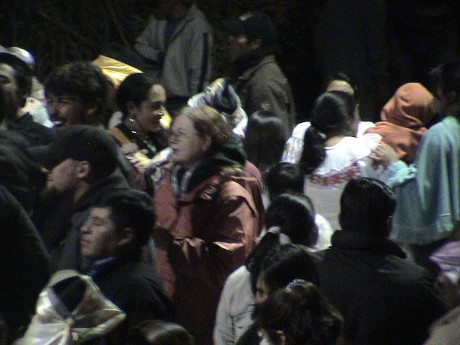 At dinner last night,
Chad announced that the project had hired some taxies to take whoever
wanted to go back to Cangahua for more of the Festival. We bit. There
was quite a bit going on. Somebody was firing bottle rockets at regular
intervals. Each local community group marched in, some in costume,
dancing to whatever music that they brought. They circled the plaza and
then spread out under the streetlights to dance. There was a band
playing that played the same music over and over, but nobody seemed to
care. Then it became clear that maybe every band in Ecuador plays the
same damn song. We heard it on the radio, on the busses, everywhere all
evening and all today.
At dinner last night,
Chad announced that the project had hired some taxies to take whoever
wanted to go back to Cangahua for more of the Festival. We bit. There
was quite a bit going on. Somebody was firing bottle rockets at regular
intervals. Each local community group marched in, some in costume,
dancing to whatever music that they brought. They circled the plaza and
then spread out under the streetlights to dance. There was a band
playing that played the same music over and over, but nobody seemed to
care. Then it became clear that maybe every band in Ecuador plays the
same damn song. We heard it on the radio, on the busses, everywhere all
evening and all today.
Sandy bought a bottle of beer and went down to dance in the crowd.
It looked pretty aerobic. Many of the PAP staff and students got
roaring drunk.
They were supposed to light a big bonfire to chase away the evil
spirits, but by the time we got pretty tired, they hadn't done it yet.
We took the 2200 shuttle back to the Hacienda. The project rented a
taxi for the duration of the project to provide transportation on
demand. The standard taxi in this area is a pickup truck with a railing
on the back to grab on to. SOME of them have a fabric covering on the
back but most don't. It was a cold and windy ride back to the Hacienda
but we made it.
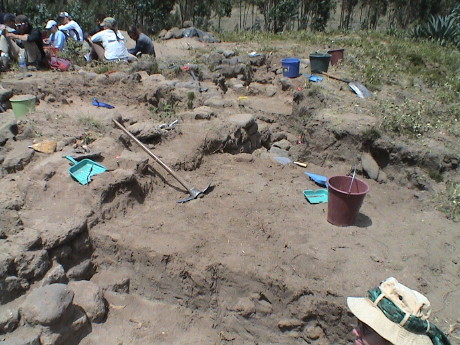 The next morning, we
were back on the regular work schedule at Molinoloma. I only lasted
until noon when I simply ran out of gas. This is unit 33 when I left.
We still have a 2x2 meter patch to excavate at least another half a
meter. This is a lot of dirt to haul out in buckets, something more
than 2 yards of dirt to move and sift by hand.
The next morning, we
were back on the regular work schedule at Molinoloma. I only lasted
until noon when I simply ran out of gas. This is unit 33 when I left.
We still have a 2x2 meter patch to excavate at least another half a
meter. This is a lot of dirt to haul out in buckets, something more
than 2 yards of dirt to move and sift by hand.
Sandy spent the morning in the lab learning to use ArcGIS, a pretty
sophisticated mapping program. She did get it running with some data
that the project had already. About noon, she hiked up to Molinoloma to
see me at about the time that I was just pooped out. I gave up and
walked down the hill, exhausted. Then I crashed for about 3 hours and
felt better. I think that I just ran out of blood sugar, a couple of
apples helped perk me up. At 1600, we caught a bus to Cayambe to buy
some more hot sauce, and other necessary supplies. We made it back in
an elapsed time of 100 minutes.
Tuesday, June 30, 2009, Hacienda Guachala, Ecuador, about 1600 ECT
(GMT -6)
Today is the biggest day of the Festival. The Foothill College
students are here as well, but they are staying at the Casa Communa in
Cangahua and I haven't seen any of them yet. Because of these events,
our schedules are different. The late arriving UCLA students and the
Foothill College students are hiking up Quitoloma today. The rest of us
get the day off.
We got our breakfast at the normal time. Today is also our
originally scheduled laundry day. However, Ana changed our schedule at
the last minute. Tuesday was overloaded with 6 bags, Friday had only 4
bags so she rescheduled Sandy to Friday. Since we could only send one
bag in today we put our most critically dirty clothing went into
Sandy's bag and it got taken to Cangahua. There are some Ecuadorian
women there that have been hired by the project to hand wash and hang
dry our laundry so it will take several days to get it back. On Friday,
my bag will go in with the rest of our very dirty clothes. Next week,
we'll get on a regular schedule. Archaeology tends to be a pretty dirty
activity so getting our laundry done is important to us. We had hand
washed some stuff in our sink because we've been on the road for 10
days already and were running out of clean clothes even though we had
been wearing what we had for two days already.
This morning Sandy worked with ArcGIS and made good progress. Then
she needed some test data so we used her GPS to mark some waypoints in
the courtyard between the stables and the lab building. Her GPS system
is an old one. It is a Holux Bluetooth connected GPS RX and some
software running on her PDA. She extracted that data from her PDA into
Excel on one of the lab computers to cross check the data. It didn't
come out very well so we redid it also measuring the points with a 50
meter tape as well. Two points next to a wall still didn't come out
well so we rechecked with the GPS receiver both in the original
position at ground level and on top of the wall. There was a major
difference. The GPS program in her PDA reports a confidence factor, all
of the bad points had a poor confidence factor. In the future, when we
take real data, we'll have to pay close attention to the confidence
factor to make sure that the GPS RX is happy with the signals that it
is getting.
We got lunch here and had planned to go to Cangahua for more of the
Festival, but by the time we got the GPS data straightened out it was
time for my stint on the duty desk from 1600 to 1830. We didn't make it
to Cangahua. The duty desk is where students and staff check out and
back in so that we know where folks are likely to be when they are not
here.
Wednesday, July 1, 2009, Hacienda Guachala, Ecuador, about 1600 ECT
(GMT -6)
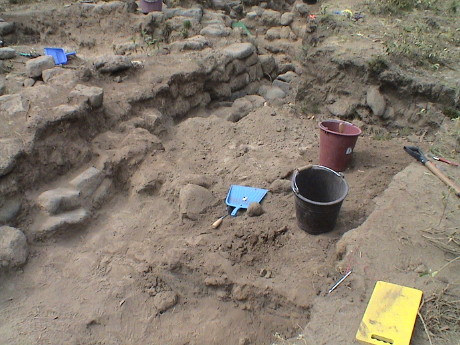 Today was our
7th work day on Molinoloma. Unit 33 made some progress since I last
took a photo on Monday morning. We're starting to expose some wall fall
outside the structure and the wall that we expected to find was indeed
there.
Today was our
7th work day on Molinoloma. Unit 33 made some progress since I last
took a photo on Monday morning. We're starting to expose some wall fall
outside the structure and the wall that we expected to find was indeed
there.
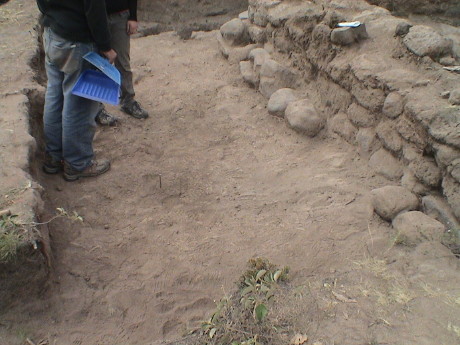 By
the time that we quit work on Wednesday we had taken the wall fall out
and leveled the floor just above the expected level of the Cangahua
blocks that we expect to find based on our excavation of unit 27. Sam
Connell, the other director from Foothill College thinks that the floor
may have predated the structures as the wall seems to be resting on
them. He also thinks that there is yet another wall to the east of the
edge of our excavations so a 1 x 2 unit was started this afternoon. I
think that the Foothill students will be excavating that one.
By
the time that we quit work on Wednesday we had taken the wall fall out
and leveled the floor just above the expected level of the Cangahua
blocks that we expect to find based on our excavation of unit 27. Sam
Connell, the other director from Foothill College thinks that the floor
may have predated the structures as the wall seems to be resting on
them. He also thinks that there is yet another wall to the east of the
edge of our excavations so a 1 x 2 unit was started this afternoon. I
think that the Foothill students will be excavating that one.
At the end of the day, I made a discovery of the first bola stone
found at the site. I didn't know what it was at first. However we found
several more. Bola stones are small round river rocks used as throwing
weapons. They are up to 5 cm in diameter and pretty hard and heavy. If
you got hit in the head by one at close range, you would be seeing
birdies at least. A direct hit could kill. Bola stones were stockpiled
at Inca forts for defense. This indicates that somebody at sometime had
been in a position to defend the site.
Thursday, July 2, 2009, Hacienda Guachala, Ecuador, about 1630 ECT
(GMT -6)
 I got
assigned to a new site today that has not been excavated at all. There
is known to be a pyramid structure here. Diego Bonifaz, the owner of
the Hacienda, has seen it, but he hired somebody to bury it least the
Ecuadorian government expropriate the land it is on. However, Diego
deeded the land to his daughter and son in law and they don't mind us
looking for it there. The area is a eucalyptus and agave covered slope.
We guessed where the edges of the structure would be and staked out a
couple of units. I got assigned to unit 2. This is what the unit looked
like just after we had scraped off some low vegetation.
I got
assigned to a new site today that has not been excavated at all. There
is known to be a pyramid structure here. Diego Bonifaz, the owner of
the Hacienda, has seen it, but he hired somebody to bury it least the
Ecuadorian government expropriate the land it is on. However, Diego
deeded the land to his daughter and son in law and they don't mind us
looking for it there. The area is a eucalyptus and agave covered slope.
We guessed where the edges of the structure would be and staked out a
couple of units. I got assigned to unit 2. This is what the unit looked
like just after we had scraped off some low vegetation.
This site is about two miles line of sight from the Hacienda, but it
is 3 or 4 miles by road to get there. I am the designated driver to get
there and back as I was the only one in the group that could drive a
stick shift. Chad had rented a "taxi" for the duration as a project
vehicle.
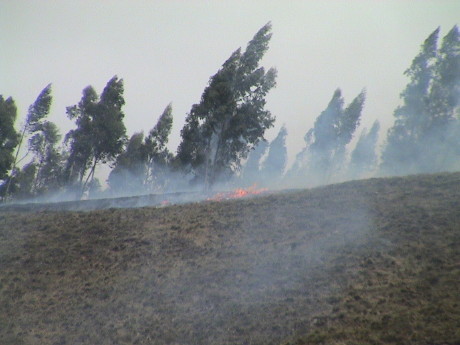 About lunchtime I
smelled smoke but I was facing the wrong way to see that a grass fire
was burning on an adjacent hilltop. We were pretty concerned, but the
wind was blowing the fire away from us. If the wind turned, it could
blow the fire down the grassy hillside into the area where we were
working. However, in about an hour, it partially burned itself out and
some locals were up there throwing dirt on the edges and put out the
parts that were still burning. The fire burned through the trees on the
hilltop without actually setting the trees on fire. We were ready to
bail out if the fire started coming in our direction.
About lunchtime I
smelled smoke but I was facing the wrong way to see that a grass fire
was burning on an adjacent hilltop. We were pretty concerned, but the
wind was blowing the fire away from us. If the wind turned, it could
blow the fire down the grassy hillside into the area where we were
working. However, in about an hour, it partially burned itself out and
some locals were up there throwing dirt on the edges and put out the
parts that were still burning. The fire burned through the trees on the
hilltop without actually setting the trees on fire. We were ready to
bail out if the fire started coming in our direction.
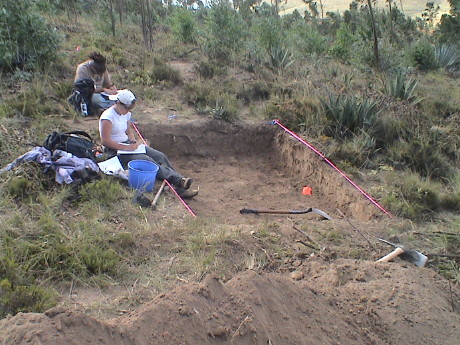 This is unit 2 at quitting time. We'd dug out a 2 x 3 meter area and
average of 50 cm deep and found nothing but some pot shards. Either we
are digging in the wrong place or we haven't gone deep enough.
This is unit 2 at quitting time. We'd dug out a 2 x 3 meter area and
average of 50 cm deep and found nothing but some pot shards. Either we
are digging in the wrong place or we haven't gone deep enough.
I haven't described the weather much. Ecuador is one of those "if
you don't like the weather, wait 5 minutes and it'll be different"
kinds of places. Nominally, it is in the 70's in the daytime and the
50's at night. The winds here change from dead calm to 25 knots in no
time at all. There can be rain out of a clear blue sky at any time, but
rarely enough, at least at this time of year, to cause a good soaking.
There are biting bugs in some places, but not at the Hacienda. On top
of some of the unprotected peaks, it can get colder and more windy. The
Mt. Cayambe volcano is about 18,000 ft high and has a permanent
glacier.
Friday, July 3, 2009, Hacienda Guachala, Ecuador, about 1700 ECT
(GMT -6)
 I
spent another day at Loma Sandoval on units 2 and 4. Unit 4 is a new
unit to extend unit 2 roughly westward as we had concluded that were
were just finding loose dirt that had been moved.
I
spent another day at Loma Sandoval on units 2 and 4. Unit 4 is a new
unit to extend unit 2 roughly westward as we had concluded that were
were just finding loose dirt that had been moved.
It was a little confusing because we got one set of instructions
from Chad, then Sam came by and issued contradictory instructions, then
Alli came by and countermanded both directors. However, we managed to
do most of what everybody wanted, maybe just not as quickly as was
hoped.
Blane and Kalli were doing the digging, Katie and I were doing most
of the sifting and we had a Ecuadorian helper, Pedro who was mostly
carrying buckets but lent a hand where necessary. A funny formation was
found almost as soon as we penetrated into the side of unit 4. It
wasn't really rock, but it was harder than the material that we had
found. It looked like blocks but wasn't uniform enough to be hand cut
and placed. We took pics and then excavated above it to see what we
could find. We'll probably tear into it on the next work day which will
be Monday.
I've been driving the pickup truck that Chad rented to the Loma
Sandoval site for two days now. It isn't very far but I'm carrying six
or more students and staff in the truck and I have to be careful not to
bang them around too much. I hadn't driven a stick shift in 23 years,
but it came back quickly.
We have two field trips scheduled for the weekend, one to do
shopping in Otavalo on Saturday and one to another archaeological site
on Sunday.
Saturday, July 4, 2009, Hacienda Guachala, Ecuador, about 1600 ECT
(GMT -6)
Our field trip today was to the town of Otavalo which is in the
northern part of Ecuador along the Pan American highway. Otavalo is a
very old trade center as it has good land connections in all
directions. Today, it is still a center of commerce, but it is also a
first class tourist trap. The place is just crammed with street
vendors. We didn't even get to the part that the locals frequent most.
I understand that that part can get VERY interesting.
 There is a square that consumes a
full city block that his been set up for street vendors like these.
There are so many of the vendors that the booths overflow into the
adjacent streets on all sides for a block or two. In some cases, they
also consume the streets parallel to the square for a couple of blocks.
Many of the vendors were selling Ecuadorian style textile products
although there was a large selection of carvings, paintings, jewelry,
leather and other products.
There is a square that consumes a
full city block that his been set up for street vendors like these.
There are so many of the vendors that the booths overflow into the
adjacent streets on all sides for a block or two. In some cases, they
also consume the streets parallel to the square for a couple of blocks.
Many of the vendors were selling Ecuadorian style textile products
although there was a large selection of carvings, paintings, jewelry,
leather and other products.
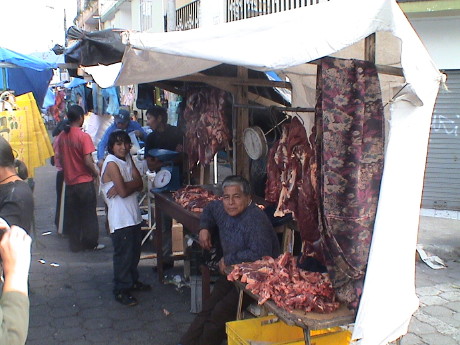 One part of the square held
vendors selling bulk food as well. This guy has set up a butcher shop
with fresh, I assume, meat hanging in the stall.
One part of the square held
vendors selling bulk food as well. This guy has set up a butcher shop
with fresh, I assume, meat hanging in the stall.
 Other vendors like this one
were selling street food. I was unwilling to take a chance on these
places, we had lunch as a Mexican restaurant that was recommended as
good and safe, although it was not cheap. The prices were about the
same as we would have expected to pay in the US for similar fare. The
place was at least half filled with other members from the project. It
turned out that maybe the Mexican restaurant wasn't such a good idea as
many of project members that ate there, including myself, had
"difficulties" later in the evening.
Other vendors like this one
were selling street food. I was unwilling to take a chance on these
places, we had lunch as a Mexican restaurant that was recommended as
good and safe, although it was not cheap. The prices were about the
same as we would have expected to pay in the US for similar fare. The
place was at least half filled with other members from the project. It
turned out that maybe the Mexican restaurant wasn't such a good idea as
many of project members that ate there, including myself, had
"difficulties" later in the evening.
The trip there and back in a bus prompted me to write about the
roads in Ecuador. The infrastructure is quite good. The road surfaces
are in good shape with wide paved shoulders (on the main roads are
least), good striping and good signage. There are guard rails where
necessary but in this region, no cliffs. These are not mountain roads.
The whole area reminds me very much of the ride along US 101 in central
California, although greener.
However, the Ecuadorian drivers are another matter altogether. Taken
as a whole, they are all nut cases. Stop (Pare) signs are virtually
ignored. Double yellow dividing lines and no passing signs are
absolutely ignored. Even oncoming traffic is ignored, it is assumed
that the drivers on both sides of the road will squeeze over to allow
somebody to pass. Slower vehicles often use their left turn signals to
signal vehicles behind that they can pass, but this causes a problem.
If the driver showing a left signal is REALLY intending to turn left
and the vehicle behind reads that as a signal to pass, then the turning
vehicle may get T-boned in the process. Somehow these folks deal with
this but after driving the project pickup truck for a couple days and
riding the busses, it drives me nuts.
[ Vacation Diaries ] [ Pambamarca 2009 ] [ Previous Page ] [ Next Page ]
© 2009 George Schreyer
Created 28 Jun 09
Last Updated July 4, 2009
 Cangahua is a pretty
small town, but they have the typical plaza with town's church on one
side. We got off the bus at the plaza and the activity was already
going on. We stopped to watch a series of dancers doing customary
Ecuadorian dance routines. Many of the dancers were children and all of
them were putting on a very good show.
Cangahua is a pretty
small town, but they have the typical plaza with town's church on one
side. We got off the bus at the plaza and the activity was already
going on. We stopped to watch a series of dancers doing customary
Ecuadorian dance routines. Many of the dancers were children and all of
them were putting on a very good show. One young man was
obviously a special dancer. He had one a traditional dancing mask and
his routine was quite polished.
One young man was
obviously a special dancer. He had one a traditional dancing mask and
his routine was quite polished. The backside
of his mask also had a face. We believe that this is because it is
considered disrespectful to face away from the sun god which is
represented by the sun. This is a tradition in Mesoamerica and it
appears to be the same here.
The backside
of his mask also had a face. We believe that this is because it is
considered disrespectful to face away from the sun god which is
represented by the sun. This is a tradition in Mesoamerica and it
appears to be the same here. On a street at one corner
of the plaza were some small shops and street vendors selling
traditional Andean clothing, hats and accessories. We didn't buy
anything because Sandy thought that the prices were a little too
high.
On a street at one corner
of the plaza were some small shops and street vendors selling
traditional Andean clothing, hats and accessories. We didn't buy
anything because Sandy thought that the prices were a little too
high. The majority of the staff
and all of the Foothill College students are staying in the Casa
Communa. This is actually an old convent located right up the street
from the plaza. The project rents the building from the church and
hires some local help to cook and clean.
The majority of the staff
and all of the Foothill College students are staying in the Casa
Communa. This is actually an old convent located right up the street
from the plaza. The project rents the building from the church and
hires some local help to cook and clean. The accommodations inside
the Casa Communa are much more spartan than the Hacienda. The staff
says that the food is actually better at the Casa Communa, but it is
pretty good at the Hacienda. The bathroom features are also communal
and there is only one bathroom although it is pretty large. I'm not
sure how they work that.
The accommodations inside
the Casa Communa are much more spartan than the Hacienda. The staff
says that the food is actually better at the Casa Communa, but it is
pretty good at the Hacienda. The bathroom features are also communal
and there is only one bathroom although it is pretty large. I'm not
sure how they work that. At dinner last night,
Chad announced that the project had hired some taxies to take whoever
wanted to go back to Cangahua for more of the Festival. We bit. There
was quite a bit going on. Somebody was firing bottle rockets at regular
intervals. Each local community group marched in, some in costume,
dancing to whatever music that they brought. They circled the plaza and
then spread out under the streetlights to dance. There was a band
playing that played the same music over and over, but nobody seemed to
care. Then it became clear that maybe every band in Ecuador plays the
same damn song. We heard it on the radio, on the busses, everywhere all
evening and all today.
At dinner last night,
Chad announced that the project had hired some taxies to take whoever
wanted to go back to Cangahua for more of the Festival. We bit. There
was quite a bit going on. Somebody was firing bottle rockets at regular
intervals. Each local community group marched in, some in costume,
dancing to whatever music that they brought. They circled the plaza and
then spread out under the streetlights to dance. There was a band
playing that played the same music over and over, but nobody seemed to
care. Then it became clear that maybe every band in Ecuador plays the
same damn song. We heard it on the radio, on the busses, everywhere all
evening and all today. The next morning, we
were back on the regular work schedule at Molinoloma. I only lasted
until noon when I simply ran out of gas. This is unit 33 when I left.
We still have a 2x2 meter patch to excavate at least another half a
meter. This is a lot of dirt to haul out in buckets, something more
than 2 yards of dirt to move and sift by hand.
The next morning, we
were back on the regular work schedule at Molinoloma. I only lasted
until noon when I simply ran out of gas. This is unit 33 when I left.
We still have a 2x2 meter patch to excavate at least another half a
meter. This is a lot of dirt to haul out in buckets, something more
than 2 yards of dirt to move and sift by hand. Today was our
7th work day on Molinoloma. Unit 33 made some progress since I last
took a photo on Monday morning. We're starting to expose some wall fall
outside the structure and the wall that we expected to find was indeed
there.
Today was our
7th work day on Molinoloma. Unit 33 made some progress since I last
took a photo on Monday morning. We're starting to expose some wall fall
outside the structure and the wall that we expected to find was indeed
there. By
the time that we quit work on Wednesday we had taken the wall fall out
and leveled the floor just above the expected level of the Cangahua
blocks that we expect to find based on our excavation of unit 27. Sam
Connell, the other director from Foothill College thinks that the floor
may have predated the structures as the wall seems to be resting on
them. He also thinks that there is yet another wall to the east of the
edge of our excavations so a 1 x 2 unit was started this afternoon. I
think that the Foothill students will be excavating that one.
By
the time that we quit work on Wednesday we had taken the wall fall out
and leveled the floor just above the expected level of the Cangahua
blocks that we expect to find based on our excavation of unit 27. Sam
Connell, the other director from Foothill College thinks that the floor
may have predated the structures as the wall seems to be resting on
them. He also thinks that there is yet another wall to the east of the
edge of our excavations so a 1 x 2 unit was started this afternoon. I
think that the Foothill students will be excavating that one. I got
assigned to a new site today that has not been excavated at all. There
is known to be a pyramid structure here. Diego Bonifaz, the owner of
the Hacienda, has seen it, but he hired somebody to bury it least the
Ecuadorian government expropriate the land it is on. However, Diego
deeded the land to his daughter and son in law and they don't mind us
looking for it there. The area is a eucalyptus and agave covered slope.
We guessed where the edges of the structure would be and staked out a
couple of units. I got assigned to unit 2. This is what the unit looked
like just after we had scraped off some low vegetation.
I got
assigned to a new site today that has not been excavated at all. There
is known to be a pyramid structure here. Diego Bonifaz, the owner of
the Hacienda, has seen it, but he hired somebody to bury it least the
Ecuadorian government expropriate the land it is on. However, Diego
deeded the land to his daughter and son in law and they don't mind us
looking for it there. The area is a eucalyptus and agave covered slope.
We guessed where the edges of the structure would be and staked out a
couple of units. I got assigned to unit 2. This is what the unit looked
like just after we had scraped off some low vegetation. About lunchtime I
smelled smoke but I was facing the wrong way to see that a grass fire
was burning on an adjacent hilltop. We were pretty concerned, but the
wind was blowing the fire away from us. If the wind turned, it could
blow the fire down the grassy hillside into the area where we were
working. However, in about an hour, it partially burned itself out and
some locals were up there throwing dirt on the edges and put out the
parts that were still burning. The fire burned through the trees on the
hilltop without actually setting the trees on fire. We were ready to
bail out if the fire started coming in our direction.
About lunchtime I
smelled smoke but I was facing the wrong way to see that a grass fire
was burning on an adjacent hilltop. We were pretty concerned, but the
wind was blowing the fire away from us. If the wind turned, it could
blow the fire down the grassy hillside into the area where we were
working. However, in about an hour, it partially burned itself out and
some locals were up there throwing dirt on the edges and put out the
parts that were still burning. The fire burned through the trees on the
hilltop without actually setting the trees on fire. We were ready to
bail out if the fire started coming in our direction. This is unit 2 at quitting time. We'd dug out a 2 x 3 meter area and
average of 50 cm deep and found nothing but some pot shards. Either we
are digging in the wrong place or we haven't gone deep enough.
This is unit 2 at quitting time. We'd dug out a 2 x 3 meter area and
average of 50 cm deep and found nothing but some pot shards. Either we
are digging in the wrong place or we haven't gone deep enough. I
spent another day at Loma Sandoval on units 2 and 4. Unit 4 is a new
unit to extend unit 2 roughly westward as we had concluded that were
were just finding loose dirt that had been moved.
I
spent another day at Loma Sandoval on units 2 and 4. Unit 4 is a new
unit to extend unit 2 roughly westward as we had concluded that were
were just finding loose dirt that had been moved. There is a square that consumes a
full city block that his been set up for street vendors like these.
There are so many of the vendors that the booths overflow into the
adjacent streets on all sides for a block or two. In some cases, they
also consume the streets parallel to the square for a couple of blocks.
Many of the vendors were selling Ecuadorian style textile products
although there was a large selection of carvings, paintings, jewelry,
leather and other products.
There is a square that consumes a
full city block that his been set up for street vendors like these.
There are so many of the vendors that the booths overflow into the
adjacent streets on all sides for a block or two. In some cases, they
also consume the streets parallel to the square for a couple of blocks.
Many of the vendors were selling Ecuadorian style textile products
although there was a large selection of carvings, paintings, jewelry,
leather and other products. One part of the square held
vendors selling bulk food as well. This guy has set up a butcher shop
with fresh, I assume, meat hanging in the stall.
One part of the square held
vendors selling bulk food as well. This guy has set up a butcher shop
with fresh, I assume, meat hanging in the stall. Other vendors like this one
were selling street food. I was unwilling to take a chance on these
places, we had lunch as a Mexican restaurant that was recommended as
good and safe, although it was not cheap. The prices were about the
same as we would have expected to pay in the US for similar fare. The
place was at least half filled with other members from the project. It
turned out that maybe the Mexican restaurant wasn't such a good idea as
many of project members that ate there, including myself, had
"difficulties" later in the evening.
Other vendors like this one
were selling street food. I was unwilling to take a chance on these
places, we had lunch as a Mexican restaurant that was recommended as
good and safe, although it was not cheap. The prices were about the
same as we would have expected to pay in the US for similar fare. The
place was at least half filled with other members from the project. It
turned out that maybe the Mexican restaurant wasn't such a good idea as
many of project members that ate there, including myself, had
"difficulties" later in the evening.